Augustus Hare
| Augustus Hare | |
|---|---|
|
| |
| Born |
13 March 1834 Rome |
| Died | 22 January 1903 (aged 68) |
| Nationality | British |
| Education | Harrow School |
| Alma mater | University College, Oxford |
| Genre | travel books |
Augustus John Cuthbert Hare (13 March 1834 – 22 January 1903) was an English writer and raconteur.
Life
He was the youngest son of Francis George Hare of Herstmonceux, East Sussex, and Gresford, Flintshire, Wales, and nephew of Augustus William Hare and Julius Hare.[1] Augustus Hare was born in Rome; later he was adopted by his aunt, the widow of Augustus Hare, and his parents renounced all further claim to him. His autobiography The Story of My Life details both a devotion to his adopted mother, Maria, and an intense unhappiness with his home education at Buckwell Place. He spent one year at Harrow School in 1847 but left due to ill health. In 1853, he matriculated at University College, Oxford, graduating in 1857 with a BA.

Hare was the author of a large number of books, which fall into two classes: biographies of members and connections of his family, and descriptive and historical accounts of various countries and cities. To the first belong Memorials of a Quiet Life (about his adoptive mother), Story of Two Noble Lives (about Charlotte Canning, Countess Canning and Louisa Beresford, Marchioness of Waterford, sisters and artists), The Gurneys of Earlham (about the bankers and social reformers of Earlham Hall near Norwich), and an autobiography in six volumes. This last included a number of accounts of encounters with ghosts. A reviewer in the New York Times concluded that "Mr Hare's ghosts are rather more interesting than his lords or his middle-class people".[2]
He also compiled numerous travel books, including a couple for John Murray, as well as many others under his own name, such as Walks in Rome, Walks in London, Wanderings in Spain, Cities of Northern, Southern, and Central Italy (separate works), Days near Rome and Sussex. He used the money he obtained on his house Holmhurst St Mary in Hastings.[3]
Hare was a friend to the barrister Basil Levett and his wife Lady Mary Levett, the daughter of the Earl of Shaftesbury, to whom Hare left a painting in his will.[4] ("Basil Levett or his wife Lady Margaret Copy of the Last Communion of S Jerome by Domenichino.")[5]
In his biography of Somerset Maugham, writer Ted Morgan mentions that Hare, whom he refers to as "the last Victorian," befriended Maugham who became a frequent guest at his country house, Holmhurst in Baldslow, Sussex.[6]
Notes
- ↑ Who's Who, Henry Robert Addison, Charles Henry Oakes, John Lawson, Published by Adam & Charles Black, London, 1900
- ↑ W.L. Alden (22 December 1900). "London Literary Letter". The New York Times Saturday Review of Books and Art. Retrieved 22 October 2011.
- ↑ Augustus Hare and Holmhurst, Umilta.net, Retrieved 31 October 2016
- ↑ Story of My Life, Augustus John Cuthbert Hare, George Allen, London, 1900
- ↑ Last Will and Testament of Augustus Hare
- ↑ Morgan, Ted, Maugham, Simon & Schuster, New York, 1980, p. 74
References
 Fryer, S. E. (1912). "Hare, Augustus John Cuthbert". In Lee, Sidney. Dictionary of National Biography, 1912 supplement. London: Smith, Elder & Co.
Fryer, S. E. (1912). "Hare, Augustus John Cuthbert". In Lee, Sidney. Dictionary of National Biography, 1912 supplement. London: Smith, Elder & Co.  This article incorporates text from a publication now in the public domain: Cousin, John William (1910). A Short Biographical Dictionary of English Literature. London: J. M. Dent & Sons. Wikisource
This article incorporates text from a publication now in the public domain: Cousin, John William (1910). A Short Biographical Dictionary of English Literature. London: J. M. Dent & Sons. Wikisource
External links
| Wikimedia Commons has media related to Augustus Hare. |
| Wikisource has original works written by or about: Augustus John Cuthbert Hare |
- The Augustus Hare Society
- Works by Augustus John Cuthbert Hare at Project Gutenberg
- Works by or about Augustus Hare at Internet Archive